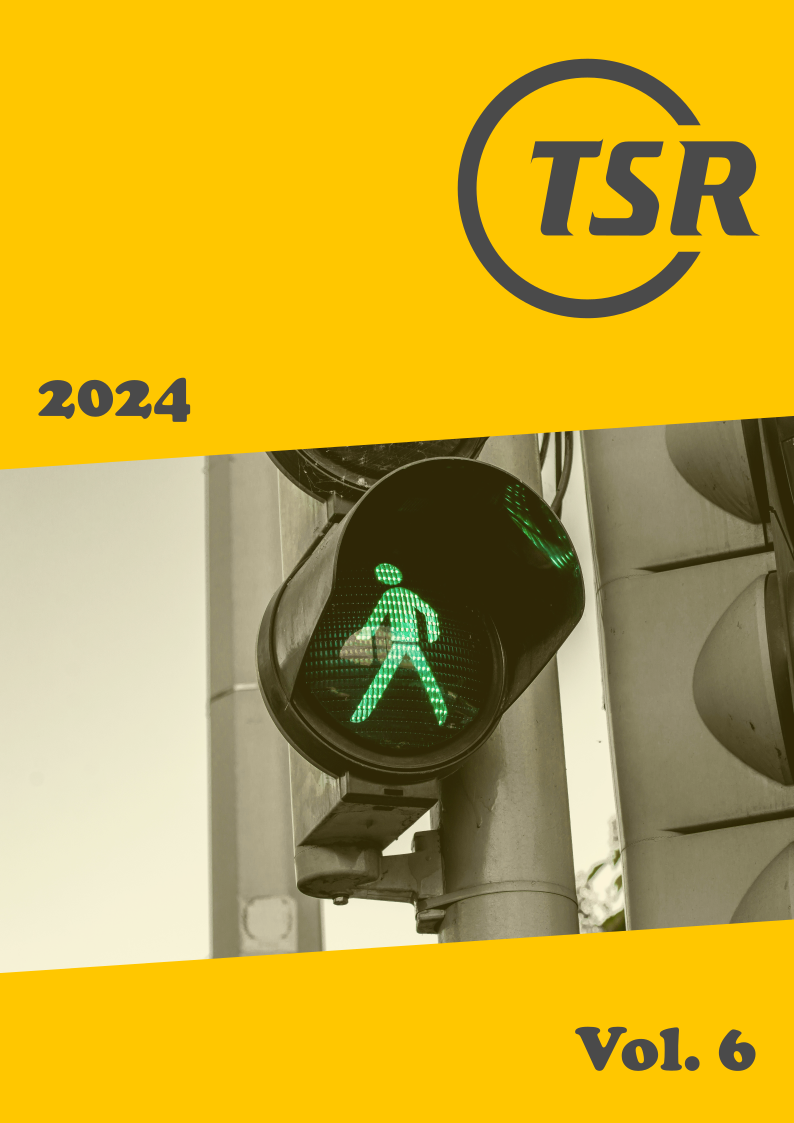Potential of heavy goods vehicle countermeasures to reduce the number of fatalities in crashes with vulnerable road users in Sweden
DOI:
https://doi.org/10.55329/dpjc9540Keywords:
active safety system, heavy goods vehicle, passive safety system, safety performance, Vision Zero, vulnerable road userAbstract
Heavy Goods Vehicles (HGVs) are involved in a large share of all serious and fatal collisions. Among these, about 30% are collisions involving Vulnerable Road Users (VRUs). The aim of the present study was to evaluate the potential of Heavy Goods Vehicle countermeasures to prevent fatalities with vulnerable road users in Sweden. Both the General Safety Regulation (GSR) and coming Euro NCAP test program were taken into account. Furthermore, elaboration on existing passive HGV safety systems were used to investigate any additive benefit. The Swedish Transport Administration carry out in-depth studies of all road fatalities. All in-depth studies for the period 2015–2020 were analysed retrospectively by a consensus group of three analysts, to assess the effectiveness of 22 active and passive safety systems. For each technology, target populations and boundary conditions were defined in order to facilitate the assessment. In total, 63 fatal crashes were found, compiled of 28 pedestrians, 13 bicyclists and 22 Powered Two Wheelers (PTWs, i.e. motorcyclists and moped riders). Overall, it was found that active and passive safety technologies could prevent up to 59% (37/63) of the included fatalities. For pedestrians, the potential of improved HGV driver vision, both with a surround view system and an improved direct vision, would have the larger potential to save lives. For bicyclists where the turn-right scenario is overrepresented, the implementation of Advanced Emergency Braking in junctions and Blind Spot Information Systems had the highest potential to save lives. For passive safety systems, HGV wheel protection had a potential to save many bicyclists by preventing them from being run over. Crash scenarios involving a PTW are the most challenging to address with HGV safety systems, mostly due to high PTW speed. Nevertheless, wheel protection on the HGV could save the lives of PTW drivers, by preventing them from being overrun. The present study showed that the included active and passive safety technologies for Heavy Goods Vehicles could prevent 59% of fatalities among vulnerable road users in Sweden. The fatalities not targeted by the HGV safety technologies included in the study would need other countermeasures such as connected safety technology (e.g. V2V or V2I), infrastructure, or education.
Downloads
References
ACEA, (2023), 'Vehicles in use Europe 2023', European Automobile Manufacturers’ Association.
Christie, N., R. Talbot, S. Reed, P. Thomas (2015), 'A84 Collisions between pedal cyclists and heavy vehicles: an in-depth analysis of fatalities in London', Journal of Transport & Health, 2(2), S49. DOI: https://doi.org/10.1016/j.jth.2015.04.572
EuroNCAP, (2023), 'Safer trucks: On the road to Vision Zero', European New Car Assessment Programme.
Forsman, Å., J. Jansson, S. Forward, R. Nuruzzaman, I. Skogsmo, A. Vadeby (2021), 'Riding in a safe system – workshop on safety for powered-two-wheelers', Swedish National Road and Transport Research Institute, VTI report 1103A.
GSR, (2019), 'General Safety Regulations', The European Parliament and the Council of the European Union.
GSR, (2021), 'General Safety Regulations update', The European Parliament and the Council of the European Union.
Hurtig, P., P. Larsson, M. Lindholm, M. Rizzi, S. Sternlund, A. Elmqvist, R. Fredriksson, Å. Forsman, A. Vadeby, K. Amin (2023), 'Analysis of Road Safety Trends 2022', Trafikverket [Swedish Transport Administration], 2023:116.
Kullgren, A., H. Stigson, A. Ydenius, A. Axelsson, E. Engström, M. Rizzi (2019), 'The potential of vehicle and road infrastructure interventions in fatal bicyclist accidents on Swedish roads: What can in-depth studies tell us?', Traffic Injury Prevention, 20(sup1), 7–12. DOI: https://doi.org/10.1080/15389588.2019.1610171
Larsson, P., C. Tingvall (2013), 'The Safe System Approach - A Road Safety Strategy Based on Human Factors Principles', 10th International Conference on Engineering Psychology and Cognitive Ergonomics (EPCE), Las Vegas, NV, USA, 21–26 July 2013. DOI: https://doi.org/10.1007/978-3-642-39354-9_3
Malczyk, A., J. Bende (2019), 'Heavy truck crashes involving pedestrians in comparison to bicyclists', 26th International Technical Conference on the Enhanced Safety of Vehicles (ESV), Eindhoven, the Netherlands, 10–13 June 2019.
Schindler, R., M. Jänsch, N. Parera (2018), 'Safety Issues for Safety System Design', Aerodynamic and Flexible Trucks for Next Generation of Long Distance Road Transport (AEROFLEX), Horizon 2020, grant agreement 769658, Deliverable D5.1.
Stigson, H. (2009), 'A safe road transport system - factors influencing injury outcome for car occupants', PhD thesis, Karolinska Institutet, Stockholm, Sweden.
Strandroth, J. (2015), 'Identifying the Potential of Combined Road Safety Interventions - A Method to Evaluate Future Effects of Integrated Road and Vehicle Safety Technologies', PhD thesis, Chalmers University of Technology, Gothenburg, Sweden.
Strandroth, J., S. Sternlund, C. Tingvall, R. Johansson, M. Rizzi, A. Kullgren (2012), 'A new method to evaluate future impact of vehicle safety technology in Sweden', Stapp Car Crash Journal, 56, 497–509. DOI: https://doi.org/10.4271/2012-22-0015
Talbot, R., S. Reed, N. Christie, J. Barnes, P. Thomas (2017), 'Fatal and serious collisions involving pedal cyclists and trucks in London between 2007 and 2011', Traffic Injury Prevention, 18(6), 657–665. DOI: https://doi.org/10.1080/15389588.2017.1291938
Thomson, R., R. Fredriksson, K. Mroz, D. Kruse, F. Törnvall (2023), 'Frontal Crash Incompatibility of Heavy Goods Vehicle In Crash Test With Passenger Car', 27th International Technical Conference on the Enhanced Safety of Vehicles (ESV), Yokohama, Japan, 3–6 April 2023.
Trafikanalys, (2024), 'Vehicles mileage on Swedish roads, 1990–2023', Transport Analysis, Sweden.
UN/ECE, (2011), 'Uniform provisions concerning the approval of I. Vehicles with regard to their lateral protection devices (LPD) — II. Lateral protection devices (LPD) — III. Vehicles with regard to the installation of LPD of an approved type according to Part II of this Regulation', Economic Commission for Europe of the United Nations, Regulation No 73.
UN/ECE, (1984), 'Uniform provisions for the approval of commercial vehicles with regard to their external projections forward of the cab's rear panel', Economic Commission for Europe of the United Nations, Regulation No. 61-00.
Wisch, M., P. Seiniger, C. Pastor, M. Edwards, C. Visvikis, C. Reeves (2013), 'Scenarios and weighting factors for pre-crash assessment of integrated pedestrian safety systems', Assessment methodologies for forward looking Integrated Pedestrian and further extension to Cyclists Safety Systems (ASPECSS), EU Seventh Framework Programme, grant agreement 285106, Deliverable 1.1.
Published
How to Cite
Issue
Section
License
Copyright (c) 2024 Tania Dukic Willstrand, Kristian Holmquist, Rikard Fredriksson, Matteo Rizzi

This work is licensed under a Creative Commons Attribution 4.0 International License.











